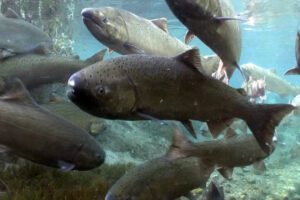
A new report from Fisheries and Oceans Canada (DFO) confirms that an estimated 28,117 salmon were caught and discarded as bycatch in the groundfish trawl fishery off the coast of British Columbia in the 2022-2023 fishing season, including some 26,273 Chinook salmon.
The DFO report, released Jan. 22, said that over 20,000 Chinook salmon were likely thrown overboard, while 3,700 were landed and subsequently discarded as waste.
The discard of the Chinooks, a major food source for a remaining 75 endangered Southern Resident killer whales, comes as the Canadian government is investing millions of dollars into protecting Southern Resident orca whales, plus millions of dollars to support wild salmon.
“The is an appalling waste for not just a salmon species that is listed as threatened and endangered in many B.C. and U.S. rivers, but also when the survival of the few remaining Southern Resident killer whales is also at stake,” Sydney Dixon, marine specialist with Pacific Wild, a Canadian charity that protects wildlife and their habitat in the Great Bear Rainforest and Northwest Pacific, said.
“The Chinook eliminated by the midwater trawl fishery during the 2022-23 fishing season could have fed three or four Southern Resident killer whales for an entire year,” Dixon said.
“Canada’s most important source of Chinook salmon for Southern Resident killer whales spawns in the Fraser River,” Dixon said.
The majority of salmon bycatch was recorded during a five-month period, with 18,867 salmon caught between Sept. 26, 2022 and Feb. 20, 2023. According to the report, this was the highest catch of Pacific salmon as bycatch recorded since 2008.
The enhanced monitoring program is to continue through the 2023-24 fishery, with additional results to be described in future reports.
The Pacific Region groundfish trawl fishery is described by DFO as one of the largest fisheries in British Columbia by catch volume and value, operating year-round using either mid-water or bottom trawl gear to target various flatfish, rockfish and other groundfish species.
The fishery consists of about 45 vessels managed under an individual transferable quota/individual vessel quota system with each vessel individually accountable for its catch.
Management of the fishery is informed by a catch monitoring program with all fishing trips required to have logbook records and independent validation via at-sea electronic monitoring and a dockside monitoring program.
The DFO report notes that recent estimates from catch monitoring data in the groundfish trawl fishery indicated that thousands of Pacific salmon were being caught on an annual basis, with most bycatch occurring using midwater trawl gear and Chinook salmon the main species being caught.
Over the past decades there have been widespread declines in Chinook salmon, and a growing number of populations are now assessed as at rick by Canada’s Committee on the Status of Endangered Wildlife.
